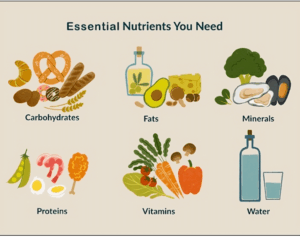🌈 Rainbow On Your Plate: The Ultimate Guide to Balanced Eating

A well-balanced diet affects physical health, mental wellbeing, and your relationship with food. If you’re aiming to feel more energised, stable, and at ease with eating, you’re in the right place.
Eating well isn’t just about nutrients—it’s about feeling your best, mentally and physically. A truly balanced diet supports sustained energy, stable mood, and overall well-being. In this comprehensive guide, we’ll cover everything you need to know about building the perfect plate, understanding macronutrients, and creating lasting healthy habits.
What Is a Balanced Diet?
A balanced diet is more than a mix of proteins, carbs, and fats—it’s the right proportion of food groups every time you eat. A balanced diet contains a variety of foods in the right proportions—carbohydrates, proteins, healthy fats, fibre, vitamins, and minerals—aligned with your energy needs.
Understanding the “why” behind balanced nutrition helps you stick to healthier habits long-term and creates a foundation for sustainable wellness that you can maintain throughout your life.
Why Balanced Eating Matters
The benefits of balanced eating extend far beyond basic nutrition:
- Provides essential macronutrients (carbohydrates, protein, fats) in optimal ratios
- Supports mood, concentration, and stable blood sugar throughout the day
- Reduces cravings, emotional eating, and binge tendencies
- Strengthens immune function and supports faster recovery
- Improves sleep quality and energy levels
For those following an active lifestyle, proper nutrition becomes even more crucial. Whether you’re working out at home with quality gym equipment or at a commercial facility, the combination of balanced eating and consistent exercise creates the foundation for optimal health and performance.
5 Key Benefits of a Balanced Diet
1. Essential Nutrients for Energy & Immunity

A balanced diet fuels your body for optimal performance by providing the building blocks needed for:
- Building and repairing muscle and tissues through adequate protein intake
- Maintaining proper brain function with healthy fats and complex carbohydrates
- Strengthening your immune system with vitamins, minerals, and antioxidants
Expert Tips for Nutrient Optimization:
- Include a rainbow of vegetables daily for diverse micronutrients
- Add lean protein sources like fish, eggs, pulses, and lean meats
- Rotate healthy fats (olive oil, nuts, seeds, avocado) throughout the week
- Choose whole grains over refined options for sustained energy
2. No More Restrictive Craving
Skipping food groups often leads to intense cravings and guilt cycles that can derail your health goals. When your plate includes carbs, protein, and fats in proper proportions:
- Your body stays satisfied for longer periods
- You’re less likely to binge or feel deprived
- Cravings become manageable rather than overwhelming
Pro Tip: If cravings persist, identify the missing nutrient rather than reaching for convenience foods. Often, what feels like a sugar craving is actually your body asking for balanced nutrition.
3. Stable Blood Sugar & Consistent Energy
Unbalanced meals lead to glucose spikes and crashes, resulting in fatigue, brain fog, and irritability. Unstable blood sugar can lead to unpleasant symptoms like hunger, shakiness, irritability, and brain fog.
A balanced plate promotes:
• Steady blood sugar levels throughout the day
• Sustained energy without afternoon crashes
• Fewer mood swings and better emotional regulation
• Improved focus and cognitive performance
| Meal Component | Blood Sugar Impact | Energy Duration |
| Refined carbs alone | Rapid spike, quick crash | 1-2 hours |
| Protein + healthy fats | Minimal spike, sustained | 4-6 hours |
| Balanced combination | Gentle rise, stable | 3-4 hours |
4. Sustained Fullness & Controlled Intake
Balanced meals contain the right mix of carbohydrates, proteins, fats, and fiber. This combination supports the release of satiety hormones like leptin and cholecystokinin (CCK), which signal fullness to the brain.
Practical Satiety Strategies:
- Choose fibre-rich carbs (vegetables, oats, pulses) to slow digestion
- Add healthy fats (avocado, nuts) to promote lasting fullness
- Always combine macronutrients—never skip fat or protein
- Include adequate protein at each meal to trigger satiety signals
5. Consistency Over Diet Trends
A balanced diet frees you from the fad diet trap by providing: • No more guilt or confusion about food choices • Adaptable and sustainable eating patterns • Confident, healthy relationship with food • Long-term success rather than short-term fixes
How to Build the Perfect Plate
Using a visual approach like the Harvard “Healthy Eating Plate,” here’s how your plate should look for optimal nutrition:
| Portion | Food Group | Examples | Key Benefits |
| ½ Plate | Fruits & Vegetables | Leafy greens, colorful fruits, legumes | Vitamins, minerals, fiber, antioxidants |
| ¼ Plate | Whole Grains | Brown rice, quinoa, oats, whole-wheat bread | Sustained energy, B vitamins, fiber |
| ¼ Plate | Lean Protein | Fish, chicken, tofu, beans, lentils | Muscle repair, satiety, amino acids |
| Small Portion | Healthy Fats & Oils | Nuts, seeds, avocado, olive oil | Vitamin absorption, brain health |
Step-by-Step Plate Building Guide
Step 1: Start with the Vegetables Fill half your plate with non-starchy vegetables. Aim for variety in colors to maximize nutrient diversity. Dark leafy greens, colorful bell peppers, broccoli, and carrots are excellent choices.
Step 2: Add Your Protein Include a palm-sized serving of lean protein. This could be grilled chicken, baked fish, tofu, legumes, or eggs. Protein helps with satiety and muscle maintenance.
Step 3: Choose Whole Grains Fill a quarter of your plate with whole grains or starchy vegetables. Brown rice, quinoa, sweet potatoes, and whole grain pasta provide sustained energy.
Step 4: Include Healthy Fats Add a thumb-sized portion of healthy fats. This helps with the absorption of fat-soluble vitamins A, D, E, and K, and supports brain function.
Step 5: Stay Hydrated Drink water or herbal tea with meals. Avoid sugary drinks that can cause blood sugar spikes and provide empty calories.
Macronutrients Breakdown: The Science Behind Balance
Carbohydrates: Your Body’s Primary Fuel
Recommended Intake: 45–65% of total daily calories Primary Functions: Energy production, brain function, muscle fuel Best Sources: Whole grains, fruits, vegetables, legumes
Carbohydrates are your body’s preferred energy source, especially for brain function and high-intensity activities. Choose complex carbohydrates over simple sugars for sustained energy release.
Quality Carbohydrate Choices:
- Whole grains (brown rice, quinoa, oats)
- Starchy vegetables (sweet potatoes, butternut squash)
- Legumes (beans, lentils, chickpeas)
- Fruits (berries, apples, bananas)
Protein: The Building Blocks
Recommended Intake: 10–35% of total daily calories Primary Functions: Muscle repair, hormone production, enzyme function Best Sources: Lean meats, fish, eggs, dairy, plant proteins
Include protein at every meal and snack—it supports muscle repair, satiety, and metabolic health. Adequate protein intake is crucial for maintaining muscle mass, especially as we age.
High-Quality Protein Sources:
- Animal proteins: Fish, poultry, lean beef, eggs, dairy
- Plant proteins: Legumes, nuts, seeds, tofu, tempeh
- Combination proteins: Quinoa, buckwheat, chia seeds
Healthy Fats: Essential for Wellness
Recommended Intake: 20–35% of total daily calories Primary Functions: Hormone production, brain health, nutrient absorption Best Sources: Nuts, seeds, avocados, olive oil, fatty fish
Healthy fats are essential for brain function, hormone production, and the absorption of fat-soluble vitamins. Focus on unsaturated fats while limiting saturated and trans fats.
Optimal Fat Sources:
- Monounsaturated: Olive oil, avocados, nuts
- Polyunsaturated: Fatty fish, walnuts, flaxseeds
- Omega-3 rich: Salmon, sardines, chia seeds
Advanced Strategies for Sustainable Eating
Color Variety Strategy
Aim for a “rainbow” of vegetables daily to ensure diverse nutrient intake. Different colored foods provide different antioxidants and vitamins:
- Red: Tomatoes, red peppers (lycopene, vitamin C)
- Orange: Carrots, sweet potatoes (beta-carotene)
- Yellow: Corn, yellow squash (lutein, zeaxanthin)
- Green: Leafy greens, broccoli (folate, vitamin K)
- Blue/Purple: Blueberries, eggplant (anthocyanins)
Meal Planning for Success
Weekly Planning Strategy:
- Batch-cook grains and proteins on weekends
- Pre-cut vegetables for easy assembly
- Prepare balanced snack combinations
- Plan for variety throughout the week
Daily Meal Timing:
- Eat within 2 hours of waking
- Space meals 3-4 hours apart
- Include protein at each meal
- Have balanced snacks available
Portion Control Made Simple
Use your hand as a guide for appropriate portions:
- Palm: Protein serving size
- Fist: Vegetable and fruit portions
- Cupped hand: Grain and starchy vegetable portions
- Thumb: Healthy fat portions
This method is convenient, portable, and naturally adjusts to your body size and needs.
Sample Balanced Meal Plans
Breakfast Options
Option 1: Protein Power Bowl
- 1 cup Greek yogurt (protein)
- ½ cup mixed berries (carbohydrates, antioxidants)
- 2 tbsp chopped nuts (healthy fats)
- 1 tbsp chia seeds (fiber, omega-3s)
- Drizzle of honey (natural sweetener)
Option 2: Balanced Smoothie
- 1 cup spinach (vegetables, minerals)
- ½ banana (natural sugars, potassium)
- 1 scoop protein powder (complete protein)
- 1 tbsp almond butter (healthy fats)
- 1 cup unsweetened almond milk (liquid base)
Lunch Options
Option 1: Mediterranean Power Bowl
- 2 cups mixed greens (vegetables, fiber)
- 4 oz grilled chicken (lean protein)
- ½ cup quinoa (complex carbohydrates)
- ¼ avocado (healthy fats)
- Cherry tomatoes, cucumber, olives (additional vegetables)
- Lemon-herb dressing (flavor, minimal added fats)
Option 2: Plant-Based Balance
- Large salad with mixed vegetables (fiber, vitamins)
- 1 cup cooked lentils (protein, carbohydrates)
- 2 tbsp pumpkin seeds (healthy fats, minerals)
- Whole grain roll (additional carbohydrates)
Dinner Options
Option 1: Classic Balanced Plate
- 4 oz baked salmon (protein, omega-3s)
- 1 cup roasted vegetables (vitamins, minerals)
- ½ cup brown rice (complex carbohydrates)
- Side salad with olive oil dressing (additional vegetables, healthy fats)
Option 2: Comfort Food Balance
- Turkey and vegetable stir-fry (protein, vegetables)
- 1 cup quinoa (complete protein, carbohydrates)
- Cashew sauce (healthy fats, flavor)
- Steamed broccoli (additional vegetables, fiber)
Troubleshooting Common Challenges
Challenge 1: Time Constraints
Quick Solutions:
- Prepare emergency balanced meals and freeze them
- Use pre-cut vegetables and fruits
- Batch cook proteins on weekends
- Keep balanced snack combinations ready
15-Minute Balanced Meals:
- Greek yogurt parfait with nuts and fruit
- Avocado toast with scrambled eggs
- Quick stir-fry with pre-cooked protein
- Balanced smoothie with protein powder
Challenge 2: Budget Limitations
Budget-Friendly Strategies:
- Buy seasonal produce when it’s cheapest
- Use frozen fruits and vegetables (equally nutritious)
- Purchase proteins in bulk and freeze portions
- Cook more meals at home instead of eating out
- Use dried beans and lentils as affordable protein sources
Challenge 3: Family Preferences
Making Balance Work for Everyone:
- Involve family members in meal planning
- Create customizable meal bases (taco bars, grain bowls)
- Offer variety within balanced frameworks
- Lead by example with your own food choices
- Gradually introduce new foods alongside familiar favorites
Challenge 4: Social Situations
Navigating Social Eating:
- Eat a balanced snack before social events
- Focus on portion control rather than food restriction
- Choose the most balanced options available
- Practice mindful eating even in social settings
- Don’t stress about occasional indulgences
The Science of Satiety and Cravings
Understanding Hunger Hormones
Leptin: The “fullness” hormone produced by fat cells Ghrelin: The “hunger” hormone produced by the stomach CCK: Released when protein and fat enter the small intestine
Balanced meals help regulate these hormones naturally, leading to better appetite control and reduced cravings.
Breaking the Craving Cycle
Common Craving Triggers:
- Skipping meals or eating irregularly
- Consuming too many refined carbohydrates
- Emotional stress or boredom
- Dehydration
- Lack of sleep
Balanced Eating Solutions:
- Eat regular, balanced meals
- Include protein and healthy fats with carbohydrates
- Stay hydrated throughout the day
- Manage stress through exercise and relaxation
- Prioritize adequate sleep
Special Considerations for Active Lifestyles
Pre-Workout Nutrition
1-2 Hours Before Exercise:
- Balanced meal with all macronutrients
- Emphasis on easily digestible carbohydrates
- Moderate protein and minimal fat
- Adequate hydration
30-60 Minutes Before Exercise:
- Light snack focused on carbohydrates
- Small amount of protein
- Avoid high-fat or high-fiber foods
- Continue hydrating
Post-Workout Recovery
Within 30 Minutes:
- 3:1 or 4:1 ratio of carbohydrates to protein
- Focus on quick absorption
- Rehydrate with water or electrolyte drink
Within 2 Hours:
- Balanced meal with all macronutrients
- Anti-inflammatory foods (berries, leafy greens)
- Adequate protein for muscle recovery
Whether you’re working out at home with reliable fitness equipment or at a commercial gym, maintaining consistent exercise routines alongside balanced nutrition creates the optimal foundation for achieving your health and fitness goals.
Adapting for Different Dietary Needs
Vegetarian and Vegan Balance
Key Considerations:
- Combine complementary proteins (rice + beans)
- Include B12 supplementation
- Focus on iron-rich foods with vitamin C
- Ensure adequate omega-3 fatty acids from plant sources
Balanced Vegan Plate:
- ½ plate: Variety of colorful vegetables
- ¼ plate: Legumes, tofu, or tempeh
- ¼ plate: Whole grains or starchy vegetables
- Healthy fats: Nuts, seeds, avocado, tahini
Gluten-Free Balance
Naturally Gluten-Free Options:
- Quinoa, brown rice, buckwheat
- All fruits and vegetables
- Lean proteins (meat, fish, eggs, legumes)
- Nuts, seeds, and healthy oils
Avoiding Processed Substitutes: Focus on whole, naturally gluten-free foods rather than processed gluten-free products, which are often higher in sugar and lower in nutrients.
Dairy-Free Balance
Calcium-Rich Alternatives:
- Leafy green vegetables
- Fortified plant milks
- Sesame seeds and tahini
- Canned fish with bones
Protein Alternatives:
- Plant-based proteins (legumes, nuts, seeds)
- Lean meats and fish
- Eggs (if tolerated)
Long-Term Success Strategies
Building Sustainable Habits
Start Small:
- Add one serving of vegetables to each meal
- Include protein at breakfast
- Replace refined grains with whole grains gradually
- Increase water intake throughout the day
Track Progress:
- Monitor energy levels and mood
- Notice hunger and fullness cues
- Keep a food diary if helpful
- Celebrate small victories
Just as investing in quality home gym equipment supports consistent exercise habits, investing time in meal planning and preparation supports consistent eating habits. Both require initial effort but pay dividends in long-term health and wellness.
Mindful Eating Practices
Techniques for Better Awareness:
- Eat without distractions (TV, phone)
- Chew food thoroughly
- Pay attention to hunger and fullness signals
- Savor flavors and textures
- Practice gratitude for your food
Creating a Positive Food Environment
At Home:
- Stock your kitchen with balanced options
- Keep healthy snacks visible and accessible
- Limit highly processed foods
- Involve family in meal preparation
At Work:
- Pack balanced lunches and snacks
- Keep emergency foods in your desk
- Stay hydrated throughout the day
- Plan ahead for busy periods
Frequently Asked Questions
What exactly is a balanced diet?
A balanced diet contains a variety of foods in the right proportions—carbohydrates, proteins, healthy fats, fibre, vitamins, and minerals—aligned with your energy needs. It’s not about restriction but about including all food groups in appropriate amounts.
How many portions of fruit and vegetables should I eat daily?
At least 5 portions daily, aiming for different colours to maximise nutrient intake. This ensures you get a wide variety of vitamins, minerals, and antioxidants essential for optimal health.
Is fiber important for fullness?
Yes—fibre slows digestion, stabilises blood sugar, and triggers satiety hormones, helping control hunger. High-fiber foods also support digestive health and may help reduce the risk of chronic diseases.
How often should I eat protein?
Include protein at every meal and snack—it supports muscle repair, satiety, and metabolic health. This helps maintain stable blood sugar and keeps you feeling satisfied between meals.
Can a balanced diet improve mental health?
A varied, nutrient-rich diet—high in fruits, vegetables, whole grains, and omega‑3 fats—is linked to improved mood, memory, and reduced stress. The gut-brain connection means that what you eat directly affects how you feel.
Can treats fit into a healthy diet?
Yes! Enjoy treats mindfully and in moderation—this prevents binge behavior and supports long-term consistency. A truly balanced approach includes flexibility for occasional indulgences within an overall healthy eating pattern.
What if I don’t like certain food groups?
Work with the foods you enjoy within each category. There are many options within each food group, so you can find alternatives that meet your nutritional needs while respecting your preferences.
How do I know if my diet is balanced?
Look for consistent energy levels, stable mood, controlled hunger, and overall well-being. You should feel satisfied after meals without experiencing extreme cravings or energy crashes.
Should I count calories on a balanced diet?
While calorie awareness can be helpful, focusing on nutrient quality and listening to hunger cues is often more sustainable than strict calorie counting. The goal is to develop a healthy relationship with food.
How long does it take to see benefits from balanced eating?
Many people notice improved energy and mood within 1-2 weeks, while other benefits like better sleep and stable weight may take 4-6 weeks to become apparent. Be patient and consistent with your efforts.
Final Takeaway: Your Path to Balanced Living
Balanced eating isn’t complicated—it’s a visual, flexible, and science-backed way to fuel yourself well. Start with the plate model, adjust portions naturally, and prioritize whole, unprocessed foods. Track how you feel—energy, mood, focus—and adjust as needed.
Remember that balance is about progress, not perfection. Every balanced meal is a step toward better health and well-being. Focus on consistency rather than perfection, and celebrate small victories along the way.
Key Principles to Remember:
- Variety is key – Include foods from all food groups
- Portions matter – Use visual cues to guide serving sizes
- Consistency beats perfection – Aim for balanced choices most of the time
- Listen to your body – Pay attention to hunger and fullness signals
- Be patient – Lasting change takes time and practice
Your Next Steps:
- Assess your current eating patterns and identify areas for improvement
- Start with one balanced meal per day and gradually expand
- Plan and prep to set yourself up for success
- Stay consistent while allowing flexibility for life’s demands
- Seek support when needed from qualified professionals
The journey to balanced eating is personal and ongoing. Focus on creating sustainable habits that work for your lifestyle, preferences, and health goals. With patience and consistency, balanced eating will become second nature, supporting you in achieving optimal health and well-being for years to come.
Remember that balanced eating works hand-in-hand with regular physical activity. Whether you’re setting up a home gym with quality equipment or working out at a commercial facility, the combination of proper nutrition and consistent exercise creates the foundation for long-term health and wellness success.










